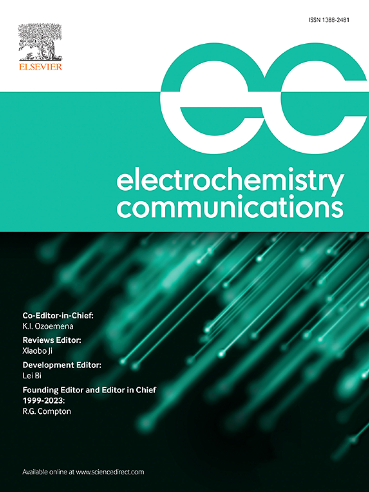酸性析氧反应中RuO2和IrO2表面取向依赖性的电化学稳定性
IF 4.2
3区 工程技术
Q2 ELECTROCHEMISTRY
引用次数: 0
摘要
Ru和ir氧化物作为聚合物电解质膜电解的酸性析氧电催化剂受到了广泛的关注。然而,目前还没有关于表面取向对电化学稳定性影响的比较研究报道。本文采用电弧等离子体沉积方法在金红石- tio2单晶衬底上制备了(hkl)取向(hkl = 110、001、100)的RuO2和IrO2薄膜,并在0.1 M HClO4中研究了表面取向对电化学稳定性的影响。在初始状态下,与IrO2相比,RuO2在所有表面取向上都表现出更低的OER过电位和更小的Tafel斜率。然而,在时间电位测量(CP)期间,RuO2过电位急剧增加,而IrO2过电位的增加明显受到抑制。CP测量后,在所有表面取向上,IrO2的过电位都小于RuO2。RuO2的取向依赖于稳定数,即CP的总电荷比与Ru或Ir的溶出量,而IrO2的取向依赖不明显。结果表明,RuO2和IrO2的表面取向不仅影响其活性,而且影响其稳定性,其中元素溶解对RuO2的影响更为显著。本文章由计算机程序翻译,如有差异,请以英文原文为准。

Surface orientation dependent electrochemical stability of RuO2 and IrO2 under acidic oxygen evolution reaction
Ru- and Ir-oxides have considerable attentions as acidic oxygen evolution electrocatalysts for polymer electrolyte membrane water electrolysis. However, there have been no reports of comparative study of electrochemical stability depending on the surface orientations. Here, we prepared the (hkl)-oriented (hkl = 110, 001, 100) RuO2 and IrO2 thin films on rutile-TiO2 single crystal substrates by arc-plasma deposition and investigated the surface orientation dependence of electrochemical stability under oxygen evolution reaction (OER) in 0.1 M HClO4. At the initial state, RuO2 showed a lower OER overpotential and smaller Tafel slope compared to IrO2 for all the surface orientations. However, the overpotential of RuO2 steeply increased during chronopotentiometry (CP) measurements, while the overpotential increase for IrO2 was significantly suppressed. After the CP measurement, the overpotential of IrO2 became smaller than that of RuO2 for all the surface orientation. RuO2 shows orientation dependence on the stability number, i.e. ratio of total charges used for CP and dissolution amount of Ru or Ir, while the IrO2 didn't show a clear trend. The results demonstrated that the surface orientation of both RuO2 and IrO2 affects not only the activity, but also the stability, and elemental dissolution and the influence is more significant for RuO2.
求助全文
通过发布文献求助,成功后即可免费获取论文全文。
去求助
来源期刊

Electrochemistry Communications
工程技术-电化学
CiteScore
8.50
自引率
3.70%
发文量
160
审稿时长
1.2 months
期刊介绍:
Electrochemistry Communications is an open access journal providing fast dissemination of short communications, full communications and mini reviews covering the whole field of electrochemistry which merit urgent publication. Short communications are limited to a maximum of 20,000 characters (including spaces) while full communications and mini reviews are limited to 25,000 characters (including spaces). Supplementary information is permitted for full communications and mini reviews but not for short communications. We aim to be the fastest journal in electrochemistry for these types of papers.
 求助内容:
求助内容: 应助结果提醒方式:
应助结果提醒方式:


